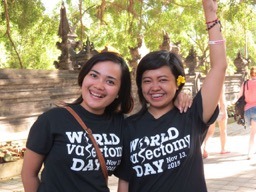Around the world, about 33% of married women opt for tubal ligation as their best guarantee of having no future births. It’s a solution that means the woman is protected regardless of partner. There’s a lot to love about it, because it protects the woman directly.
On the other hand, there are some disturbing statistics about tubal ligation. The risk of failure goes up after the first year, and of those failures, 15 to 20% are likely to be ectopic pregnancies. An ectopic pregnancy is dangerous because the embryo attaches to the fallopian tube rather than inside the uterus, and as it grows, it can cause the tube to burst and lead to life-threatening internal bleeding. It’s estimated that between 10 and 20 million women experience ectopic pregnancies each year.
In the developed world, ectopic pregnancy that is detected early rarely leads to maternal death, but in the developing world, the risk to the mother is far higher. The consequences to the family are catastrophic, because without mothers to care for the children, the fathers are compromised in their ability to work, or the children’s futures are jeopardized.
No one can forget the images of the distraught father on his knees crying, “Why?” in Chhattisgarh, India in 2014 when the terrible tragedy occurred at a female sterilization camp, killing 12 women. This poor man held his head and asked how he was to care for his small children.
There is another option for some families: vasectomy. As a procedure, it’s safer, cheaper, more effective, has an extremely low failure rate even over time, and when it does fail, results in a healthy pregnancy rather than an ectopic one. It’s also a way for a man to take responsibility for his own seed, rather than relying on women to do this for him.
Women on average are fertile for 45 years. They take chemicals or have IUDs inserted in their uteruses to prevent pregnancy when they are still thinking of having children. They endure pregnancy and birth for their families. But for women who are in monogamous relationships and have the number of children they want, why are they having major abdominal surgery when the alternative is a 10 to 20 minute procedure on an easily accessed part of the body, with a painless test to make sure it worked, and that statistically is not only safer but more effective?

The tides may be turning. For the first time this year, the Bill and Melinda Gates Foundation’s International Conference on Family Planning, which is the largest family planning conference in the world, will include a track on male contraception. Countries like Kenya, Haiti, Mexico, Colombia, Cuba, India, Bangladesh, Bhutan, Indonesia and many more are either starting or enlarging their vasectomy outreach, doctor training, and vasectomy programs.
The hurdles are high; demystifying vasectomy for populations of men who rarely see doctors, are often working, and who don’t necessarily share contraception information with other men makes it hard to target information to them. However, when they are given accurate information and the offer of a procedure using modern no scalpel methods, men are increasingly eager to have vasectomies. They understand the role of a smaller family size in giving their children better lives, and many welcome the chance to take the burden off their partners.

Assuming that publicity efforts are successful and demand increases, having highly trained doctors that also have had enough practice and sufficient ongoing experience to give quality vasectomies can be an issue. Even though the procedure is a simple surgery, it has some variables that require attention and practice.
Men can be uncomfortable going to family planning clinics to sit with women awaiting services, and can also find working with women health workers to be embarrassing. It can work the other way too, where men are reluctant to have another man touch their genitals.
In the US, permanent contraception is available under the Affordable Care Act for women, but not for men, automatically making it more practical financially for the woman to get the surgery, even though the actual costs are much higher.
Beyond these obstacles, the fact is that there is no profit in vasectomy. There are no pharmaceutical companies that can sell pills or injections or other commodities (other than condoms) to men, so there’s very little sponsorship or funding for vasectomy programs.
When men are ignored by the family planning community, however, the consequences are often faced by women. They bear the pregnancies, the abortions, the tubal ligations, and the risks. There are limited paths for men to become more enlightened about family planning, couples’ communication, gender equity or their own health.
World Vasectomy Day and other organizations are trying to tackle this issue, understand its causes and consequences, and change not only the way family planning organizations include this method, but how governments and international bodies adopt programs that inform, educate, publicize and provide services.
In direct contradiction of the stereotype, results so far have shown that men, who want the best for their partners and children, are very willing to accept vasectomy when given the correct information. They don’t want more children than they can afford, and appreciate being able to control that. World Vasectomy Day has also found that men can be profoundly grateful for help, and that the majority do it as an act of love for their partners and children.
The MAHB Blog is a venture of the Millennium Alliance for Humanity and the Biosphere. Questions should be directed to joan@mahbonline.org
MAHB Blog: https://mahb.stanford.edu/blog/vasectomy-womens-issue/
The views and opinions expressed through the MAHB Website are those of the contributing authors and do not necessarily reflect an official position of the MAHB. The MAHB aims to share a range of perspectives and welcomes the discussions that they prompt.
